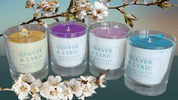
Key Terms Used For Scented Candles and Wax Melts
, by Corinna Stanley, 3 min reading time

, by Corinna Stanley, 3 min reading time
Scented Candle Key Terms Below are some explanations of the key terms used to describe scented candles and wax melts, to help you understand candle descriptions and make an informed choice when buying scented candles and wax melts.
Below are some explanations of the key candle and wax melt terms to help you understand candle descriptions and make an informed choice when buying scented candles and wax melts. You can explore our range of scented candles and wax melts at Quaver&Lyric Candles and Melts.
Dried leaves, petals or other parts of plants added to wax melts or candles as decoration.
The total number of hours that a candle burns for.
The fragrance given by the candle or melt before lighting or melting.
A candle in a container, usually glass or metal.
This is the term for the label that gives the legally required hazard statements, signal words and for candles pictograms.
An oil produced from the distillation of plant extracts can be from one plant only but more often are blends of oil from different plants.
These are a series of tests conducted to check the fire safety of the candle.
The liquid fragrance oil used in candles and melts to give them their scent. Many fragrance oils are blends of both essential oils and synthetic fragrance oils.
The description of a fragrance in three parts. Top notes are the scents given off first, usually citrus or fruity and give the first impression of the fragrance of the candle. Middle notes are the heart of the fragrance and are often the fruity, floral or spicy scents. Base notes are the longer lasting scents of the fragrance and may include musk or woody scents.
This is the scent released while being used. For a candle during burning and for a melt this is when it has been warmed and melted to release the fragrance.
The International Fragrance Association
IFRA acts as a watchdog, setting standards for the safe use of fragrance ingredients. These standards apply to a wide range of products you encounter daily, from perfumes and cosmetics to detergents and air fresheners. Their mission is two-fold: ensuring the safety of consumers and protecting the environment.
IFRA doesn't just set standards, they also provide resources for manufacturers. These resources help companies comply with regulations and follow best practices when formulating fragranced products.
Powder added to wax to add colour and a sheen to the wax used in wax melts it should not be used in candles.
Another term for paraffin wax. This is a wax produced from the by-products of the manufacture of fuels.
A term often used to describe waxes made using oils from plants such as soy, rapeseed and coconut. Also known as plant wax.
A free standing candle not in a container.
Tests carried out to check the candle does not produce too much soot when burnt. If the candle is tested to meet the requirements of BS EN 15426:2018 (Candles – Specification for Sooting Behaviour) the test needs to be carried out using specialized soot testing equipment in a controlled environment.
These are manufactured fragrance oils rather than being extracted from plants. These can be Nature identical fragrances which are made to contain the identical chemicals found in essential oils.
We hope these terms help you to understand the terms used by candle makers. You can find more information on choosing candles in our guide to buying scented candles and wax melts.
Browse the Quaver&Lyric range now.